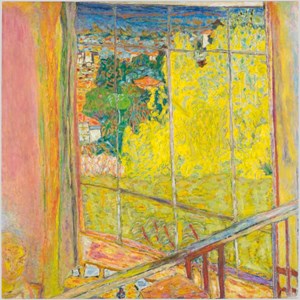
In January 2019 Tate Modern will stage the UK’s first major Pierre Bonnard exhibition in 20 years, showing the work of this innovative and much-loved French painter in a new light.
In January 2019 Tate Modern will stage the UK’s first major Pierre Bonnard exhibition in 20 years, showing the work of this innovative and much-loved French painter in a new light. The exhibition will bring together around 100 of his greatest works from museums and private collections around the world. It will reveal how Bonnard’s intense colours and modern compositions transformed painting in the first half of the 20th century, and will celebrate his unparalleled ability to capture fleeting moments, memories and emotions on canvas.
Spanning four decades from the emergence of Bonnard’s unique style in 1912 to his death in 1947, Tate Modern’s exhibition will show how the artist constructed his vibrant landscapes and intimate domestic scenes from memory. At once sensuous and melancholy, these paintings express moments lost in time – the view from a window, a stolen look at a lover, or an empty room at the end of a meal. These motifs can be seen in breakthrough works likeDining Room in the Country 1913 (Minneapolis Institute of Art) in which he brought interior and exterior spaces together to create a vibrant atmosphere, while the bright colours of works like The Lane at Vernonnet 1912-14 (Scottish National Gallery of Modern Art, Edinburgh) exemplify how his joyful palette could still evoke the poignancy of a moment gone forever.
The exhibition will emphasise Bonnard as a 20th century artist who – like his friend and contemporary Henri Matisse – had a profound impact on modern painting and would become an influential figure for later artists like Mark Rothko and Patrick Heron. Bonnard will be repositioned as a man who engaged with the world around him, revealing overlooked areas of his activities – from his frequent travels around France and his practice of working on different subjects side by side, to his response to the crises of both the First and Second World War. Alert to his surroundings, he developed unconventional compositions in his paintings of everyday life: his landscapes collapsed into layers of dense foliage, such as Summer 1917 (Fondation Maeght) and street scenes, as in Piazza del Popolo, Rome 1922 (private collection), were simplified into friezes. Perhaps most famously, his interior scenes like Coffee 1915 (Tate) and Nude in an interior c.1935 (National Gallery of Art, Washington) caught domestic life at uncanny moments and reframed them from snatched points of view.
A variety of these domestic scenes mark out Bonnard’s career, often showing figures in quiet contemplation, apparently oblivious to the viewer’s gaze. The artist’s wife Marthe de Méligny was a continual subject in these images. She suffered from various illnesses throughout her life and treated these with what was then called hydrotherapy through repeated bathing. Bonnard’s paintings of her bathing, drying and dressing, are among his most iconic works. They form key markers in his development as an artist, as his partner’s withdrawal from the outside world becomes a shared psychological story captured in paint.
Bonnard’s process of reimagining through memory also allowed his paintings to become more abstract. This is already evident in the bands of contrasting colour in works like The Violet Fence 1922 (Carnegie Museum of Art, Pittsburgh) but reaches a high-point in the vivid Studio with Mimosa 1939-46 (Musée National d'Art Moderne - Centre Pompidou, Paris). The exhibition will conclude with a group of stunning works created towards the end of Bonnard’s life, while spending the Second World War in Le Cannet living with scarce resources and the anxiety of invasion. These panoramic views and vibrant garden scenes show the artist looking back on a lifetime of memories and working on the brink of abstraction.
Pierre Bonnard: The Colour of Memory is curated at Tate Modern by Matthew Gale, Head of Displays, with Helen O’Malley and Juliette Rizzi, Assistant Curators. The exhibition is organised by Tate Modern in collaboration with Ny Carlsberg Glyptotek, Copenhagen and Kunstforum Wien.
Image on top: Pierre Bonnard, The Studio with Mimosas, 1939-46, Musee National d'art Moderne - Centre Pompidou, Paris

ArtDependence Magazine is an international magazine covering all spheres of contemporary art, as well as modern and classical art.
ArtDependence features the latest art news, highlighting interviews with today’s most influential artists, galleries, curators, collectors, fair directors and individuals at the axis of the arts.
The magazine also covers series of articles and reviews on critical art events, new publications and other foremost happenings in the art world.
If you would like to submit events or editorial content to ArtDependence Magazine, please feel free to reach the magazine via the contact page.